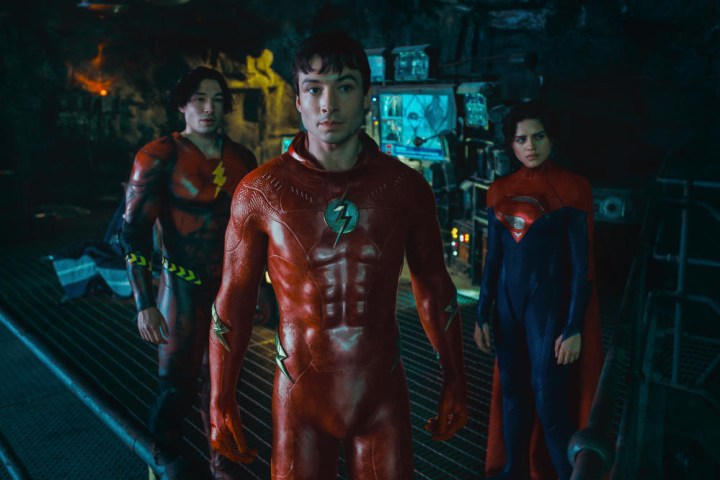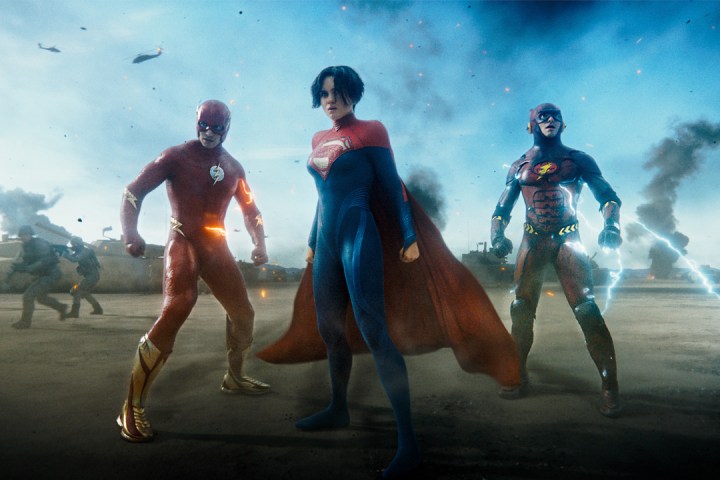
Warning: This article contains major spoilers for The Flash (2023).
The Flash revolves entirely around one decision. The film is sent hurtling into its second act when its lead, Barry Allen (Ezra Miller), decides to travel back in time and stop his mother’s death from ever happening. In doing so, Barry creates a world where Bruce Wayne is played by Michael Keaton instead of Ben Affleck, Supergirl (Sasha Calle) made it to Earth instead of her cousin, Kal-El (Henry Cavill), Arthur Curry (Jason Momoa) was never born, and a version of Barry himself got to grow up with knowing what it was like to live without his parents.
While Barry tries desperately to make this new reality work, his actions ultimately lead to him, his younger self, Calle’s Supergirl, and Keaton’s older Batman being Earth’s only line of defense against General Zod (Michael Shannon) and his army of evil Kryptonians. Without Henry Cavill’s Clark Kent around to beat Zod, Barry begins to realize that the world he’s created with his time-traveling actions is destined to be terraformed and destroyed.
The Flash’s third act climax, consequently, sees both Barry and his younger self repeatedly try and fail to prevent Zod’s forces from killing Supergirl and Batman. When Barry finally accepts that he has to let his mother die in order to prevent total chaos, he ends up in a standoff in the Speed Force with not only his brasher, younger self but also a future version of himself who refuses to let anyone he loves die. Standing there, Barry is forced to try and convince his two alternate selves that they have to let go of their mother’s life if they want to save the world.

It’s at this moment that The Flash throws out a series of badly-realized CGI cameos. While standing in the dimensional center of their universe, the film’s three versions of The Flash all watch as multiple different timelines begin crashing into each other. Director Andy Muschietti briefly takes viewers into each of these crumbling universes, which include the world seen in Richard Donner’s Christopher Reeve-led Superman films, the version of reality featured in the Adam West-starring Batman TV series, and a timeline that is protected by a version of Superman played by Nicolas Cage.
All of these actors and characters, including Reeves’ Superman, Cage’s Superman, and Helen Slater’s Supergirl, are brought to “life” using the kind of de-aging and deepfake effects that have become increasingly popular. Whether or not these “cameos” are considered successful may vary from viewer to viewer, but The Flash thankfully doesn’t dwell too long on its third-act references. After flashing through each of its alternate realities, the film turns its attention back to its three central variants just in time to show Barry Allen’s younger self sacrificing his life in order to save his older, wiser self.
His sacrifice results in the destruction of his and Barry’s evil, time-traveling variant, which clears the way for Miller’s original version of The Flash to travel back in time and undo his actions from earlier in the film. While doing so, he gives himself a chance to say goodbye to his mother and finds a seemingly harmless way to clear his imprisoned father’s name in the present. When he then returns to his original timeline, Barry makes it to his father’s appeal hearing just in time to see his innocence finally proven in front of a judge.
As he’s in the midst of celebrating his victory outside the courthouse moments later, though, The Flash finds time for one more shocking cameo from none other than Batman & Robin star George Clooney. The film then cuts to black on an image of its eponymous hero trying — and failing — to hide his confusion over the appearance of yet another Bruce Wayne he’s never seen before.

The Flash doesn’t go too far out of its way to explain its last twist, which is mostly played for laughs. It’s unclear if the film’s final erasure of Ben Affleck’s Batman from Barry’s universe is permanent or something he can undo without having to reverse his father’s exoneration. Either way, The Flash doesn’t seem all that concerned with explaining itself in its final moments, and it’s not hard to see why. As one of the last entries in Warner Bros.’ now-abandoned Snyderverse, The Flash doesn’t have much of a responsibility to end on a concrete note.
On the contrary, all that The Flash really has to do is help send the Snyderverse out in style. It doesn’t totally succeed at doing that, but not for a lack of trying. In the end, the film’s reintroduction of all of Warner Bros.’ past DC franchises as different realities that still exist in the same multiverse not only cements the Snyderverse’s place in DC history but also begins the failed franchise’s now-inevitable abandonment.
Before long, the Snyderverse will be nothing more than just another one of the past worlds featured in The Flash. With that in mind, The Flash’s final image of Barry Allen smiling as one of his teeth falls out feels like an oddly fitting last shot for a film that had the rug pulled out from under it long before it had the chance to build any momentum.
The Flash is now playing in theaters.



